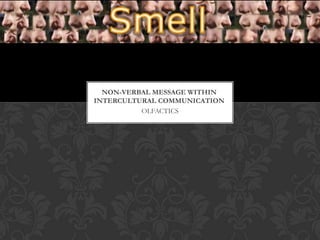Non verbal message within intercultural communication(olfactics)
•Download as PPTX, PDF•
5 likes•29,084 views
Report
Share
Report
Share

Recommended
More Related Content
What's hot
What's hot (20)
literary theories and approaches simplified version

literary theories and approaches simplified version
National cultural variables in business communication

National cultural variables in business communication
Role of language and discourse into the cultural studies

Role of language and discourse into the cultural studies
Similar to Non verbal message within intercultural communication(olfactics)
Similar to Non verbal message within intercultural communication(olfactics) (20)
Diana MODULE-3-UCSP.pptx............................

Diana MODULE-3-UCSP.pptx............................
Diana MODULE-3-UCSP.pptx............................

Diana MODULE-3-UCSP.pptx............................
Running Head ETHNOCENTRISM AND CULTURAL RELATIVISM .docx

Running Head ETHNOCENTRISM AND CULTURAL RELATIVISM .docx
Recently uploaded
Recently uploaded (20)
Scaling API-first – The story of a global engineering organization

Scaling API-first – The story of a global engineering organization
Exploring the Future Potential of AI-Enabled Smartphone Processors

Exploring the Future Potential of AI-Enabled Smartphone Processors
Automating Google Workspace (GWS) & more with Apps Script

Automating Google Workspace (GWS) & more with Apps Script
The Role of Taxonomy and Ontology in Semantic Layers - Heather Hedden.pdf

The Role of Taxonomy and Ontology in Semantic Layers - Heather Hedden.pdf
Powerful Google developer tools for immediate impact! (2023-24 C)

Powerful Google developer tools for immediate impact! (2023-24 C)
Handwritten Text Recognition for manuscripts and early printed texts

Handwritten Text Recognition for manuscripts and early printed texts
Apidays Singapore 2024 - Building Digital Trust in a Digital Economy by Veron...

Apidays Singapore 2024 - Building Digital Trust in a Digital Economy by Veron...
08448380779 Call Girls In Diplomatic Enclave Women Seeking Men

08448380779 Call Girls In Diplomatic Enclave Women Seeking Men
Presentation on how to chat with PDF using ChatGPT code interpreter

Presentation on how to chat with PDF using ChatGPT code interpreter
08448380779 Call Girls In Civil Lines Women Seeking Men

08448380779 Call Girls In Civil Lines Women Seeking Men
Strategize a Smooth Tenant-to-tenant Migration and Copilot Takeoff

Strategize a Smooth Tenant-to-tenant Migration and Copilot Takeoff
08448380779 Call Girls In Greater Kailash - I Women Seeking Men

08448380779 Call Girls In Greater Kailash - I Women Seeking Men
Non verbal message within intercultural communication(olfactics)
- 1. NON-VERBAL MESSAGE WITHIN INTERCULTURAL COMMUNICATION OLFACTICS
- 2. WHAT IS OLFACTICS? o Olfactics is a sense of smell which use in nonverbal communication. o According to Gibbons human can detect as many as 10 000 different compounds by smell. o 1% of our genes are devoted to detecting odors. o Human have more olfactory genes than other type of gene identified in mammalian DNA. o Gibbons suggest that our lack of maybe because we lack of vocabulary for smell and are discourage talking about smell.
- 3. Social scientist discovering that olfactory sensation is a potent influence on social interaction. Survey data indicate that a significant percentage of adult are conscious of and influenced by smell in their environment. In their poll of more than 350 American adults, the olfactory Research Fund found that 64% of respondents indicate that smell greatly influenced the quality of their lives.
- 4. CULTURAL DIFFERENCE IN OLFACTICS • Based on study by Kate Fox(Anthropologist and the Director of the Social Issues Research Center in Oxford, England on the cultural differences in olfactics which emphasis on non-Western cultures, where by unlike western cultures, smell is “the emperor of the senses’ in many cultures. • Example, Fox describes the importance of smell among the Ongee people in Andaman Island, a group of island off the south-east coast of India. Because their calendar based on the smell of flower that bloom at different times of a year.
- 5. • Fox also describes smell ritual among the Bororo peoples of Brazil and the Serer Ndut of Senegal (Western Africa). - Bororo, personal body smell indicates the life force of the individual, whereas, one’s breath odor indicates the stage of person’s soul. -Ndut believe that individual posses a physical smell, defined by one’s body and breath odor, and spiritual smell. The spiritual smell is thought to be reincarnated smell. For example, the Ndut can tell which ancestor has been reincarnated by associating the smell of a child to that of a deceased person.
- 6. The exchange or mixing of odors among people is carefully prescribed. For example, among the Amazonian Desana, members of a particular tribal group are thought to share a similar odor. Marriage is only allowed between people of different odors. This is similarly to the Batek Negrito of the malay Peninsula, people of similar odor group are prohibited from engaging in sexual intercourse and even sitting too close to each other. The Batek Negrito believe that the prolonged mixing of similar odors causes illness in the people themselves and any children they may conceive.
- 7. Apart from that, Fox also writes that the Western smell preferences are not universal. Example, the Dassanetch(a tribal cattle-raising group in Ethiopia) believe that the smell of cows is the most pleasing of all smells. Dassanetch men routinely wash their hands in cattle urine and smear their bodies with cuttle manure. Such smells are associated with status and fertility. The Dogon people of Mali find the scent of onions very attractive, especially for young men and women, who rub fried onions all over their bodies.
- 8. http://www.youtube.com/watch?v=HQz6Y02Tor4 (olfactics) http://www.youtube.com/watch?v=akwNLPiFj0I (smell in communication) SOME VIDEO ABOUT OLFACTICS
- 9. SUMMARY Example: • Western culture — fear of offensive natural smells (billion dollar industry to mask objectionable odors with what is perceived to be pleasant ) — again connected with “attractiveness” concept. • Many other cultures consider natural body odors as normal (Arabic). • Asian cultures (Filipino, Malay, Indonesian, Thai, Indian) stress frequent bathing and often criticize western culture of not bathing often enough!
- 10. REFERENCE Olfactics CHAPTER 8(THE NONVERBAL CODE) INTERCULTURAL COMMUNICATION Page 308-315 http://www.fb9dv.uni-duisburg.de/ti/en/education/teaching/ss07/multiculti/presentation%203.pdf
